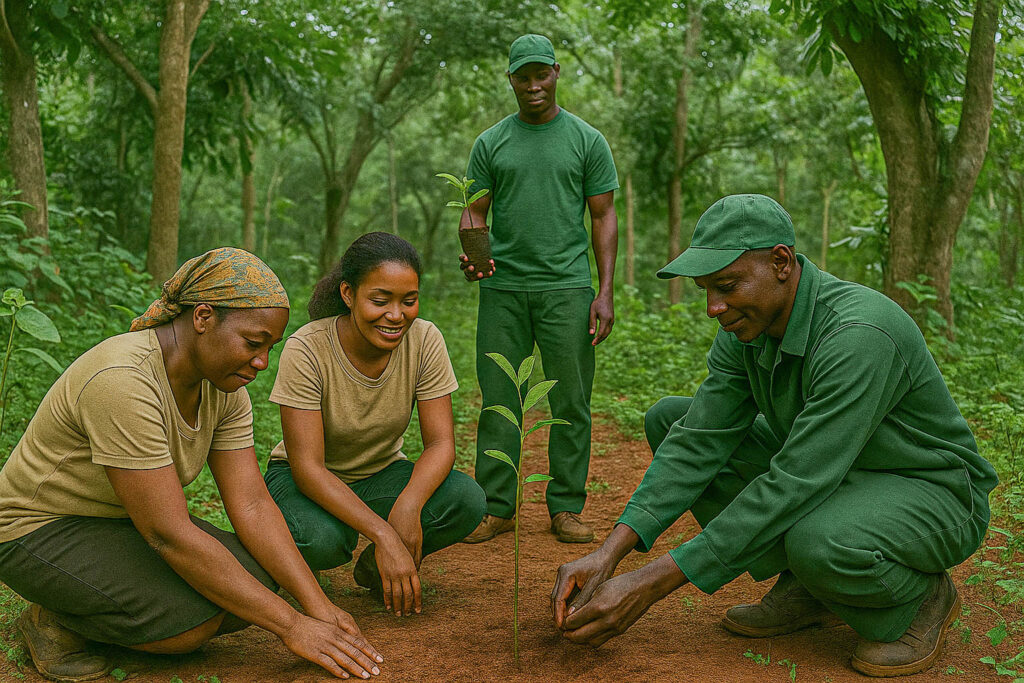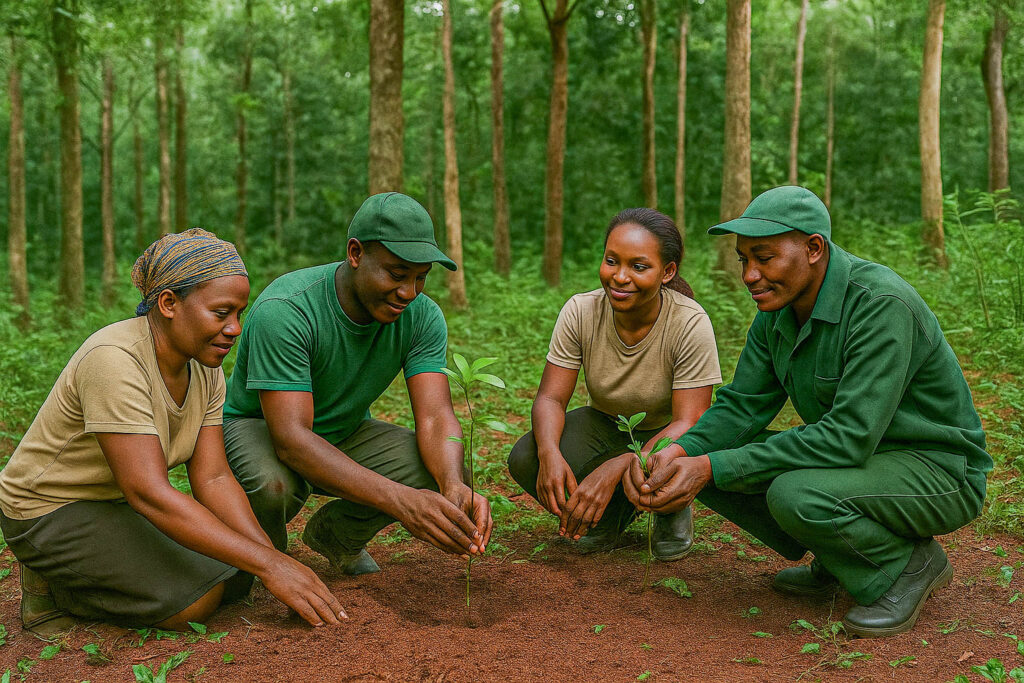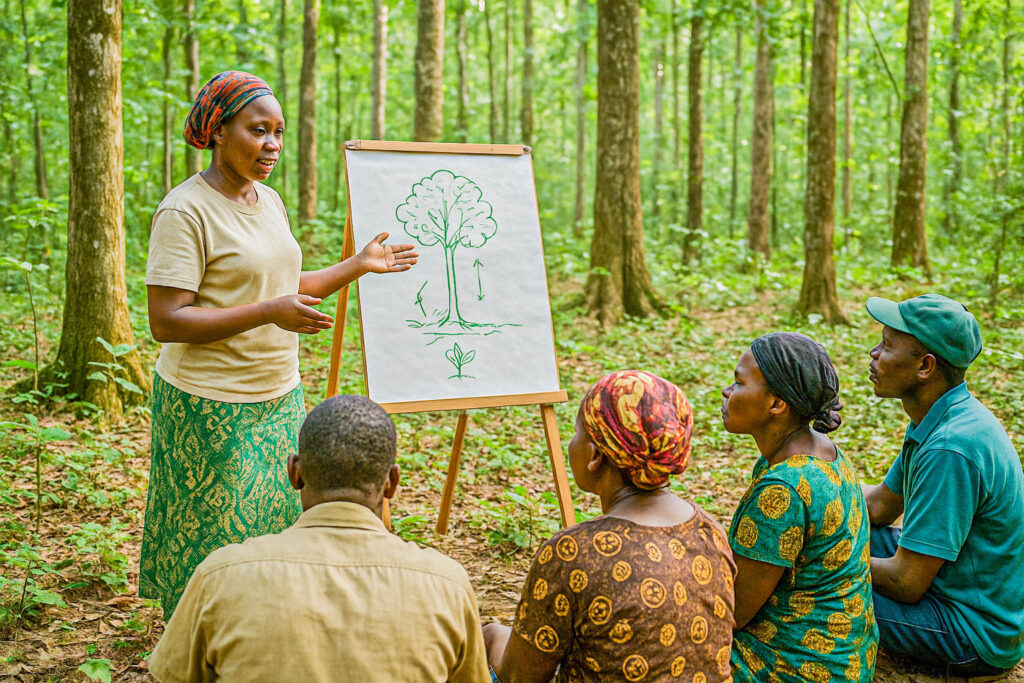Climate Change Mitigation-Forest-Based Solutions for Global Climate Action

Climate change represents one of the most pressing challenges of our time, with forests playing a critical role in both the problem and the solution. Our climate change mitigation programs harness the immense potential of forest ecosystems to sequester carbon, regulate climate, and build resilience against climate impacts. We recognize that effective climate action must benefit both the global community and local forest-dependent populations.
Forests currently absorb approximately 2.6 billion tons of carbon dioxide annually—about one-third of CO₂ emissions released from fossil fuel burning. However, deforestation and forest degradation contribute approximately 11% of global carbon emissions. Our climate mitigation work addresses this dual challenge by protecting existing carbon stocks while creating new carbon sinks through forest restoration and sustainable management practices.
Carbon Sequestration Projects
Developing High-Impact Carbon Projects Our carbon sequestration projects are designed to generate significant, measurable, and verifiable emission reductions while creating sustainable income streams for forest communities. We focus on projects that demonstrate additionality—meaning they would not have occurred without carbon finance—and permanence, ensuring long-term carbon storage.
Project Development and Implementation We follow rigorous international standards in developing carbon projects:
- Baseline Assessments: We conduct comprehensive assessments of existing carbon stocks and projected emissions scenarios to establish accurate baselines for measuring project impact.
- Methodology Selection: We select appropriate carbon accounting methodologies from recognized standards including the Verified Carbon Standard (VCS), Gold Standard, and Plan Vivo, choosing approaches that best fit local conditions and community capabilities.
- Community Engagement: From project inception, we ensure meaningful community participation in project design, implementation, and benefit-sharing arrangements. Communities are not just beneficiaries but active partners in project management.
- Technical Implementation: We provide technical support for all aspects of project implementation, including forest inventory, monitoring protocols, and data management systems.
Carbon Measurement and Verification Accurate carbon measurement is essential for project credibility and success:
- Forest Inventory Systems: We establish permanent sample plots and train communities to conduct regular forest inventories using standardized protocols that track tree growth, mortality, and carbon accumulation.
- Remote Sensing Integration: We combine ground-based measurements with satellite imagery and aerial photography to monitor forest changes across entire project areas.
- Third-Party Verification: All our carbon projects undergo independent third-party verification to ensure accuracy and compliance with international standards.
- Monitoring and Reporting: We establish long-term monitoring systems that track project performance and generate regular reports for carbon buyers and regulatory bodies.
Community Benefit-Sharing Carbon projects must provide tangible benefits to participating communities:
- Direct Payments: Communities receive direct payments based on verified carbon sequestration, with payment structures designed to ensure equitable distribution and long-term sustainability.
- Capacity Building: We invest carbon revenues in community capacity building, including training in sustainable forest management, alternative livelihoods, and project management skills.
- Infrastructure Development: Carbon revenues support community infrastructure development including schools, health facilities, and improved transportation access.
- Enterprise Development: We use carbon project revenues to capitalize community-based enterprises that provide ongoing income beyond carbon payments.
Nature-Based Climate Solutions
Landscape-Scale Climate Interventions Nature-based climate solutions work with natural processes to address climate change while providing multiple co-benefits for biodiversity, communities, and ecosystem services. Our landscape-scale approach recognizes that effective climate solutions must consider entire ecosystems and the communities that depend on them.
Reforestation and Afforestation Initiatives We design and implement large-scale tree planting programs that maximize climate benefits:
- Species Selection: We prioritize native species that are well-adapted to local conditions and provide multiple benefits including timber, fruits, medicines, and wildlife habitat. Species selection considers projected climate conditions to ensure long-term survival.
- Community Nurseries: We establish community-managed tree nurseries that provide seedlings for reforestation while creating local employment and building technical capacity.
- Planting Strategies: We employ diverse planting strategies including direct seeding, seedling transplantation, and natural regeneration assistance, selecting approaches based on site conditions and community preferences.
- Maintenance and Protection: We establish long-term maintenance protocols including protection from fire, grazing, and illegal harvesting, with communities taking primary responsibility for tree survival and growth.
Agroforestry Systems Development Agroforestry integrates trees with agricultural systems to provide climate benefits while improving food security and farm productivity:
- System Design: We work with farmers to design agroforestry systems that are appropriate for local conditions, including alley cropping, silvopasture, and forest gardens.
- Technical Training: Farmers receive comprehensive training in agroforestry techniques including tree management, soil conservation, and integrated pest management.
- Market Linkages: We help farmers access markets for agroforestry products including fruits, nuts, timber, and medicinal plants.
- Research and Development: We conduct on-farm research to optimize agroforestry systems for local conditions and continuously improve practices based on farmer experience and scientific evidence.
Wetland and Riparian Restoration Wetlands and riparian forests provide exceptional climate benefits while supporting biodiversity and community livelihoods:
- Restoration Planning: We develop comprehensive restoration plans that consider hydrology, soil conditions, and community uses of wetland areas.
- Native Vegetation Establishment: We plant native wetland and riparian species that provide habitat for wildlife while offering sustainable resources for communities.
- Water Management: We implement water management systems that restore natural hydrology while providing benefits such as flood control and groundwater recharge.
- Community-Based Management: We establish community management systems for restored wetlands that ensure long-term sustainability while providing ongoing benefits to local populations.
Forest Adaptation Strategies
Preparing Forests for Climate Change As climate conditions change, forests must adapt to new temperature and precipitation patterns. Our forest adaptation strategies help both natural forests and planted forests adjust to changing conditions while maintaining their ecological functions and community benefits.
Assisted Migration Programs Climate change may outpace the natural migration of tree species, requiring human intervention to maintain forest health:
- Climate Modeling: We use climate projections to identify areas where current tree species may become unsuitable and determine appropriate species for future conditions.
- Seed Source Selection: We collect seeds from populations that are adapted to warmer or drier conditions and introduce them to areas that will experience similar conditions in the future.
- Trial Plantings: We establish trial plantings to test the performance of different species and seed sources under local conditions before implementing large-scale programs.
- Community Training: We train communities to recognize climate adaptation needs and implement assisted migration techniques as part of their forest management activities.
Genetic Diversity Conservation Maintaining genetic diversity within forest species is crucial for their ability to adapt to changing conditions:
- Seed Collection and Storage: We establish seed collection and storage programs that preserve genetic diversity from multiple populations of important tree species.
- Ex-Situ Conservation: We maintain living collections of important tree species in community forests and conservation areas to preserve genetic resources.
- Breeding Programs: Where appropriate, we support community-based tree breeding programs that develop varieties adapted to projected climate conditions.
- Population Monitoring: We monitor the health and genetic diversity of tree populations to identify those at risk and prioritize conservation efforts.
Climate-Resilient Management Practices Forest management practices must evolve to maintain forest health under changing climate conditions:
- Diversified Forest Composition: We promote diverse forest compositions that include multiple species with different climate tolerances, reducing vulnerability to climate shocks.
- Adaptive Silviculture: We develop and implement silvicultural practices that enhance forest resilience, including selective harvesting, thinning, and regeneration techniques.
- Fire Management: We develop community-based fire management systems that use controlled burning and firebreaks to reduce the risk of catastrophic wildfires.
- Pest and Disease Management: We establish monitoring and response systems for forest pests and diseases that may become more problematic under changing climate conditions.
Climate Resilience Building
Strengthening Community and Ecosystem Resilience Climate resilience involves the ability of communities and ecosystems to withstand, adapt to, and recover from climate shocks. Our resilience building programs address both immediate climate risks and long-term adaptation needs.
Diversified Livelihood Strategies Economic diversification reduces community vulnerability to climate-related shocks:
- Climate-Resilient Agriculture: We promote agricultural practices that maintain productivity under variable climate conditions, including drought-tolerant crops, water-efficient irrigation, and soil conservation techniques.
- Forest-Based Enterprises: We develop forest-based enterprises that provide income even during climate shocks, including sustainable harvesting of climate-resilient forest products.
- Financial Services: We support the development of savings and credit systems that help communities prepare for and recover from climate-related losses.
- Skills Development: We provide training in diverse skills that create livelihood options less dependent on climate-sensitive activities.
Improved Water Management Water security is fundamental to both community and ecosystem resilience:
- Watershed Management: We implement comprehensive watershed management programs that protect water sources, reduce erosion, and maintain water quality.
- Water Storage Systems: We support the construction of community water storage systems including tanks, ponds, and groundwater recharge systems.
- Irrigation Efficiency: We promote water-efficient irrigation techniques that maintain agricultural productivity while conserving water resources.
- Drought Preparedness: We help communities develop drought preparedness plans that include water conservation measures, alternative water sources, and emergency response protocols.
Disaster Risk Reduction Planning Proactive disaster risk reduction reduces the impact of climate-related disasters:
- Risk Assessment: We conduct participatory risk assessments that identify climate hazards, vulnerabilities, and existing coping strategies.
- Early Warning Systems: We establish community-based early warning systems that provide advance notice of climate-related threats such as floods, droughts, and storms.
- Emergency Response Plans: We help communities develop emergency response plans that define roles, resources, and procedures for responding to climate disasters.
- Recovery Planning: We support post-disaster recovery planning that builds back better and reduces future vulnerability.
Ecosystem-Based Adaptation Natural ecosystems provide critical services that help communities adapt to climate change:
- Natural Infrastructure: We promote the use of natural infrastructure such as wetlands, forests, and grasslands to provide services like flood control, water filtration, and erosion prevention.
- Biodiversity Conservation: We protect and restore biodiversity that provides essential adaptation services, including genetic resources for crop improvement and natural pest control.
- Ecosystem Service Enhancement: We implement management practices that enhance ecosystem services relevant to climate adaptation, such as water regulation and soil protection.
- Landscape Connectivity: We maintain and restore landscape connectivity that allows species and ecosystems to migrate and adapt to changing conditions.
Integrated Climate Action and Measurable Impact
Synergistic Climate Solutions Our climate change mitigation programs achieve maximum impact through integration of carbon sequestration, nature-based solutions, forest adaptation, and resilience building. This integrated approach recognizes that effective climate action must address both mitigation and adaptation while providing immediate benefits to forest communities.
Quantifiable Climate Outcomes Our comprehensive climate mitigation work has achieved significant measurable results:
- Carbon Sequestration: Generated over 1.2 million verified tons of CO₂ emission reductions through forest carbon projects, with an additional 800,000 tons in the verification pipeline.
- Forest Restoration: Restored 18,500 hectares of degraded forest landscapes, establishing carbon sinks that will continue growing for decades.
- Agroforestry Adoption: Supported 2,350 farmers to adopt agroforestry practices covering 12,000 hectares, improving both carbon storage and agricultural productivity.
- Climate Resilience: Implemented climate adaptation measures in 32 communities, benefiting over 25,000 individuals with improved resilience to climate variability.
- Livelihood Diversification: Created climate-resilient income opportunities for over 1,800 households through forest-based enterprises and sustainable agriculture.
- Water Security: Improved water security for 15 communities through watershed restoration and water management interventions.
Long-Term Climate Impact Our forest-based climate solutions are designed for long-term impact and sustainability. Through our mitigation programs, we contribute to global climate goals while demonstrating that climate action can create opportunities and improve livelihoods for forest-dependent communities. Our integrated approach serves as a model for scaling forest-based climate solutions across Africa and other developing regions.
Climate change mitigation through forest-based solutions represents one of the most cost-effective and socially beneficial approaches to addressing the climate crisis. Through our comprehensive programs, we prove that effective climate action enhances rather than constrains community development, creating a foundation for sustainable development in a changing climate.






Responses